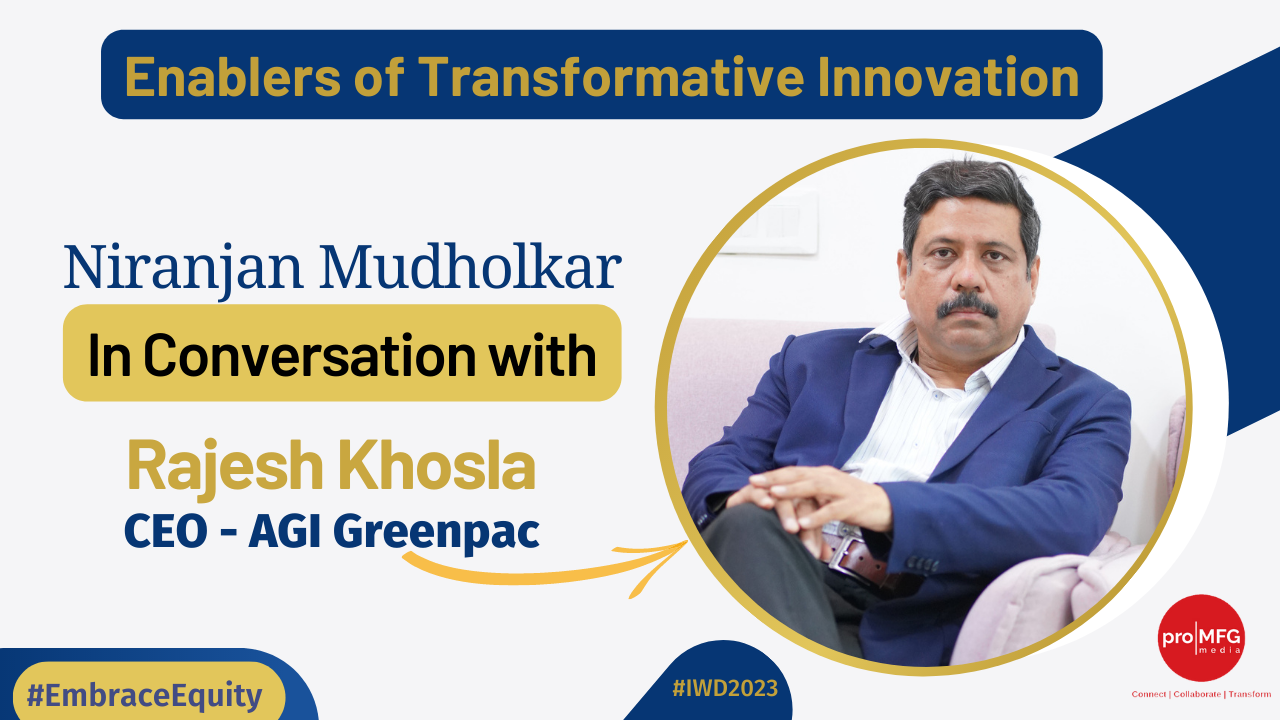Enablers of Transformative Innovation
#IWD2023 #EmbraceEquity #RajeshKhosla #AGIGreenpac #WomenInManufacturing“It is a matter of concern that women’s presence in the manufacturing sector in India remains low, accounting for just one-third of the workforce. It is essential to address the barriers that prevent women from entering and advancing in the manufacturing industry. Women are great enablers of transformative innovation in other sectors, and we can leverage their expertise in the manufacturing sector in several ways.”

March 2023: On the occasion of the International Women’s Day 2023, Rajesh Khosla, CEO of AGI Greenpac, explains that “women can play a critical role in developing the talent needed to drive innovation in the manufacturing industry, by mentoring, coaching, and providing leadership development opportunities for the next generation of innovators”, in this thought-provoking interaction with Niranjan Mudholkar, Editorial Director, Pro MFG Media
In what ways can women drive transformative innovation in the manufacturing industry?
It is encouraging to see that women have played a significant role in driving expansion, innovation, and sustainability efforts in the manufacturing industry over the past decade. However, it is also a matter of concern that women’s presence in the manufacturing sector in India remains low, accounting for just one-third of the workforce. It is essential to address the barriers that prevent women from entering and advancing in the manufacturing industry. Women are great enablers of transformative innovation in other sectors, and we can leverage their expertise in the manufacturing sector in several ways, including:
Leadership and representation: Women in leadership roles ensure that they are represented in decision-making positions which can lead to more diverse original and innovative solutions to complex challenges.
Collaboration and networking: Women are excellent collaborators and their ability can be leveraged for better and more efficient cross-functional innovation and the identification of new business opportunities.
Fostering a culture of innovation: Women help create a culture of innovation that encourages risk-taking, experimentation, and continuous improvement.
Developing talent: Women can play a critical role in developing the talent needed to drive innovation in the manufacturing industry, by mentoring, coaching, and providing leadership development opportunities for the next generation of innovators.
What are the hindrances women in India face in entering the manufacturing sector and progressing in it?
There are several barriers that women in India face when foraying into the manufacturing sector. These include recruitment and promotion biases, lack of educational opportunities, discriminatory societal norms and standards, inadequate institutional frameworks, infrastructural and physical safety deficiencies, and legal and regulatory issues, amongst others.
Addressing these barriers will require a multifaceted approach that will involve the government, industry, and society at large to come together. It may include policy and regulatory changes, education and training programmes, initiatives to promote gender diversity and inclusion in the workplace, and efforts to address social and cultural norms.
What measures can be taken to overcome these hindrances?
Several measures can be taken to overcome the hindrances women face in entering and progressing in the manufacturing sector in India, including:
Implementing gender diversity policies: Companies can implement gender diversity policies and initiatives that promote equal opportunities for men and women, such as offering mentorship and training programmes, flexible work arrangements, and initiatives to support work-life balance.
Providing access to education and training: Providing access to education and training programmes that equip women with the necessary skills and knowledge to succeed will help women overcome educational disparities and enhance their employability.
Addressing infrastructural deficiencies: Improving infrastructure, such as transportation, sanitation, and housing, can help women access manufacturing jobs in some locations.
Promoting gender equality: Addressing social and cultural norms that perpetuate gender biases and stereotypes, such as traditional gender roles and expectations, can help create a more inclusive and supportive environment for women in the manufacturing sector.
Creating a supportive ecosystem: Government and industry associations can provide funding and support for women-led businesses and initiatives, such as incubation centres, accelerators, and networks, to help women overcome the barriers they face while setting up a manufacturing plant.
What obstacles do women employees encounter while working in the manufacturing sector? What steps can ‘manufacturing firms’ take to tackle these obstacles?
Women employees working in the manufacturing sector may encounter several obstacles, including discrimination and bias, physical safety concerns, limited career advancement opportunities, and a lack of work-life balance.
Manufacturing firms can implement policies and initiatives that promote gender diversity and inclusion in the workplace, provide training and resources to employees and managers on diversity and inclusion, prevent harassment, and create a supportive work environment. Manufacturing firms can promote career advancement opportunities, address physical safety concerns and provide resources and support to balance work and family responsibilities, such as childcare and parental leave policies.
Firms must engage with industry associations and policymakers to advocate for policies and initiatives that support gender diversity and inclusion in the manufacturing sector.
Are there any recent advancements made in gender equity in manufacturing?
Yes, there have been some recent advancements made in gender equity in the Indian manufacturing sector.
Women’s Employment: The Indian government has launched several initiatives to promote women's employment in the manufacturing sector. For instance, the Ministry of Skill Development and Entrepreneurship has launched the Mahila Coir Yojana, a scheme to provide self-employment opportunities to women in the coir industry. Similarly, the Ministry of Micro, Small, and Medium Enterprises has launched the Annapurna scheme, which provides loans to women entrepreneurs engaged in food processing activities.
Gender-Responsive Policies: Many companies in the Indian manufacturing sector have implemented gender-responsive policies to promote gender equity. Some companies have introduced flexible work arrangements, including work-from-home options and flexible working hours, to enable women to balance work and family responsibilities.
Training and Development: Some companies in the manufacturing sector have initiated training and development programmes specifically designed for women employees. These programmes aim to enhance women’s skills and capabilities and provide them with opportunities for career growth and advancement.
These initiatives will help the sector move in the right direction towards greater gender equity in the Indian manufacturing sector.
Please tell us what AGI Greenpac is doing to engage, encourage and empower women in its workforce across different functions?
AGI Greenpac is committed to engaging, encouraging, and empowering women in its workforce across different business verticals including the shop floor. Our company has taken several measures to promote diversity, equity, and inclusion, including:
Training and development: We provide regular training & development opportunities for our employees, including women. This helps them to acquire new skills and knowledge and to advance in their careers.
Policies for physical safety and sexual harassment: We have policies in place to ensure the physical safety and well-being of all our women employees.
Increasing women workforce on shop floors: We are continuously making conscious efforts to increase the number of women on the shop floors across our plants.
Fostering a culture of inclusion: Our company’s HR team works on fostering a culture of inclusion where both men and women can work together effectively.
NEWSLETTER
TRENDING ON PRO MFG
MORE FROM THE SECTION









